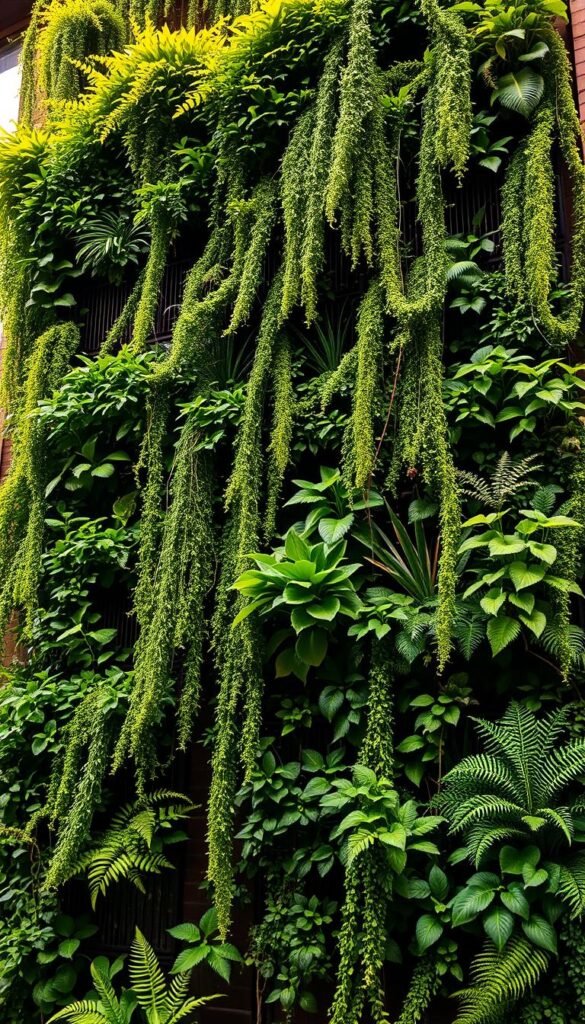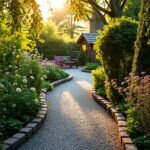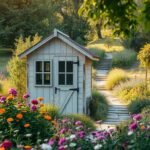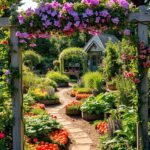Imagine turning blank walls into lush, breathing ecosystems that improve air quality while making your space feel alive. Studies show plant-filled environments boost immune systems and reduce stress—office workers near green walls report healthier skin, while spas use these installations to create calming atmospheres. Whether you’re in a bustling city like New York or a cozy suburban home, vertical systems let you grow upwards instead of outwards.
These living designs do more than save space. They add privacy, soften harsh architecture, and turn dull areas into vibrant focal points. For urban dwellers with limited yards, container gardening ideas pair perfectly with vertical setups to maximize every square foot. Even better: modern systems use self-watering tech and lightweight materials, making upkeep simpler than you’d expect.
You’ll discover how to choose between living walls (ideal for intricate designs) and living fences (great for boundaries). We’ll explore plant combinations that thrive vertically—like mixing trailing ivy with drought-tolerant succulents—and share tips to avoid common pitfalls. By the end, you’ll see how these gardens blend beauty with practicality, transforming walls into functional art.
Introduction to Vertical Garden Design
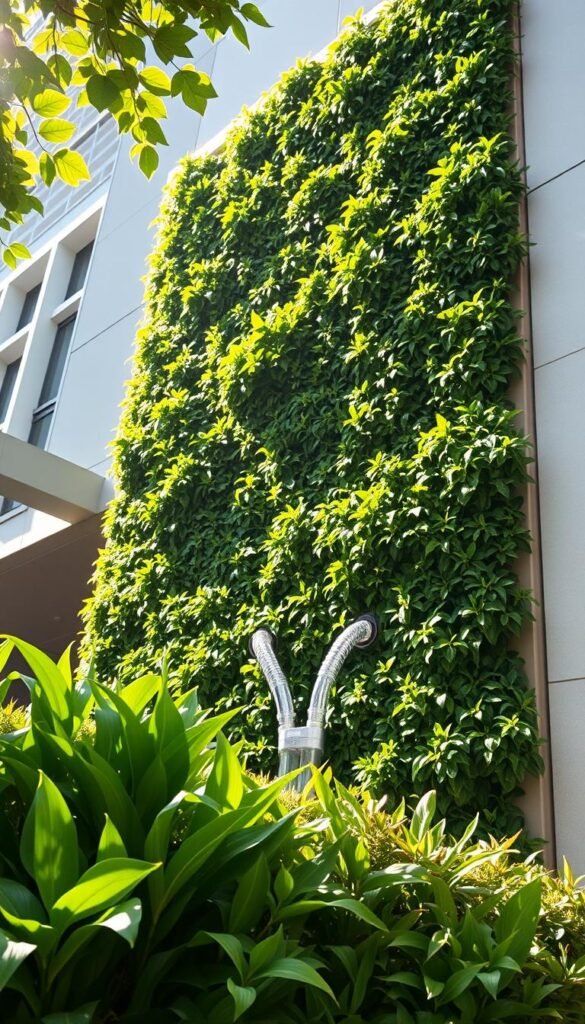
Consider the walls around you not just as structures, but as living canvases teeming with foliage and vitality. These dynamic systems blend artistry with ecology, offering fresh solutions for cramped urban settings and spacious suburban homes alike.
Green Wall Systems: Pockets vs. Troughs
You’ll find two main approaches for building plant-filled surfaces. Pocket-style setups use fabric or plastic containers filled with compost, while trough-based designs create seamless planting beds. Metal or plastic frameworks securely hold these elements—some require professional mounting, while freestanding options simply need anchoring to prevent tipping.
Why Your Space Needs Vertical Greenery
Beyond their visual appeal, these installations deliver measurable benefits. Research shows they remove airborne toxins 15% faster than potted arrangements. “The vertical orientation increases leaf surface area exposed to airflow,” explains a recent horticulture study. This design also discourages pests, letting you grow herbs or flowers with fewer chemicals.
Urban dwellers gain particular advantages. A 4×6-foot setup can hold 50+ plants—triple what fits in equivalent ground space. You’ll enjoy natural privacy screens and reduced noise from busy streets. Even property values rise; homes with curated green features sell 7% faster in competitive markets.
Planning Your Vertical Garden Project
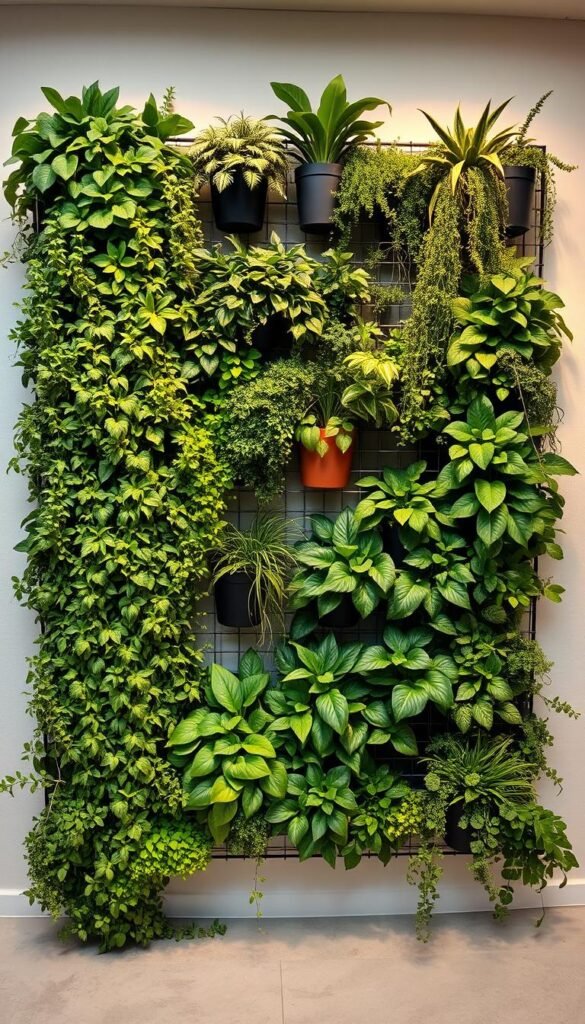
Ready to transform that empty wall or fence into a thriving plant display? Start by understanding your space’s unique needs. Measure the area carefully—even a 3×5-foot section can hold 20+ plants if designed well.
Assessing Your Space, Sunlight, and Soil Conditions
Track sunlight patterns for 2-3 days. Use a free app like Sun Seeker to map shadows. Full-sun spots (6+ hours daily) suit herbs like rosemary, while ferns thrive in shaded walls. For ground-based setups, test soil drainage: dig a 12-inch hole, fill with water. If it drains slower than 1 inch/hour, mix in gravel or sand.
Selecting the Right Wall or Fence Structure
Walls handle weight better—a 4×8-foot wall system with wet soil weighs ~300 lbs. Fences need reinforcement: use pressure-treated wood or metal frames. Check local codes—most areas allow 6.5-foot fence heights without permits. For shared boundaries, discuss plans early to avoid disputes over moisture or overgrowth.
| Feature | Wall | Fence |
|---|---|---|
| Max Load Capacity | Up to 50 lbs/sq ft | 30 lbs/sq ft |
| Height Limit | Unrestricted* | 6.5 ft (varies) |
| Neighbor Approval Needed? | Only for shared walls | Yes for boundaries |
Consider maintenance access—leave 18 inches clearance for pruning. Pair vertical setups with space-saving ground layouts for layered greenery. Always anchor freestanding units securely; wind can topple poorly mounted systems.
For detailed installation tips, consult seasonal planting guides. Proper planning now prevents soggy walls or sun-starved plants later!
Constructing Your Green Wall: A Step-by-Step Guide
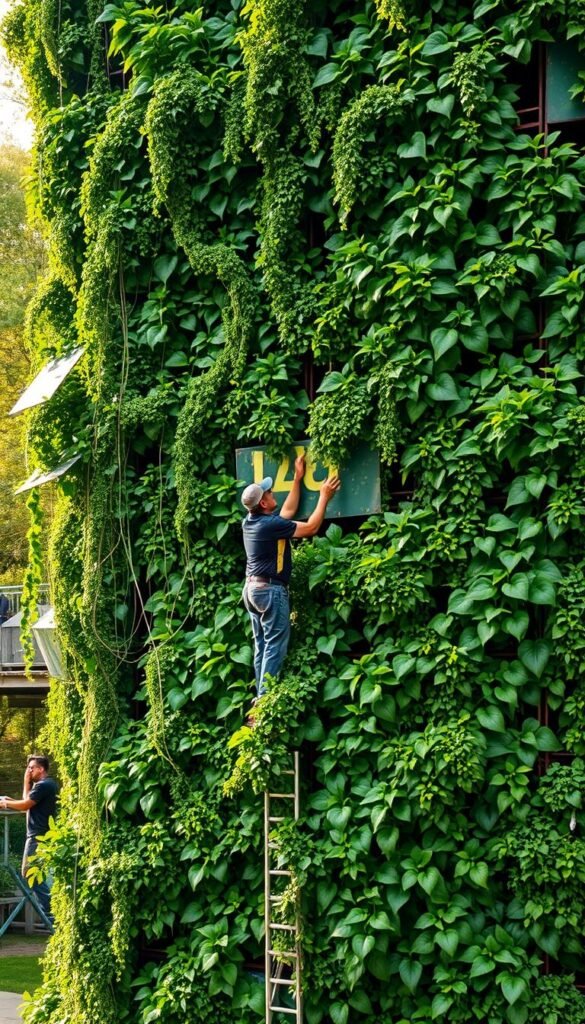
Building a sturdy vertical garden starts with proper preparation. Let’s break down the process into manageable stages, ensuring your project stays on track from groundbreaking to final touches.
Materials, Tools, and Installation Essentials
Gather these supplies before starting:
| Tools | Materials |
|---|---|
| Circular saw | 6″×6″ cedar posts |
| ½” × 10″ drill bit | 50-lb concrete bags |
| 3′-6′ level | Fabric garden pockets |
| Post hole digger | Lag bolts & washers |
Always call 811 to check for underground utilities first. Dig two 30″-deep holes using your auger, keeping them 18″ square. Mix concrete in your wheelbarrow—sixteen bags should fill both holes. Set metal post bases into the wet mix, aligning them with a taut string line.
Tips from Experts on Setting Posts and Frames
Let concrete cure for 24 hours before attaching posts. Cut 6″×6″ boards to 7′ lengths using your circular saw. Secure them to bases with 10″ lag bolts, checking plumb with your level every step.
Attach horizontal runners 18″ from the top, then space others 11″ apart. This creates ideal overlap for fabric pockets. Pro tip: Pre-drill holes in cedar boards to prevent splitting when driving screws.
Mount garden pockets using their grommet points, staggering plants for full coverage. Add perpendicular braces between runners for extra support—they’ll handle the weight of wet soil and mature plants.
Choosing Plants and Irrigation Systems
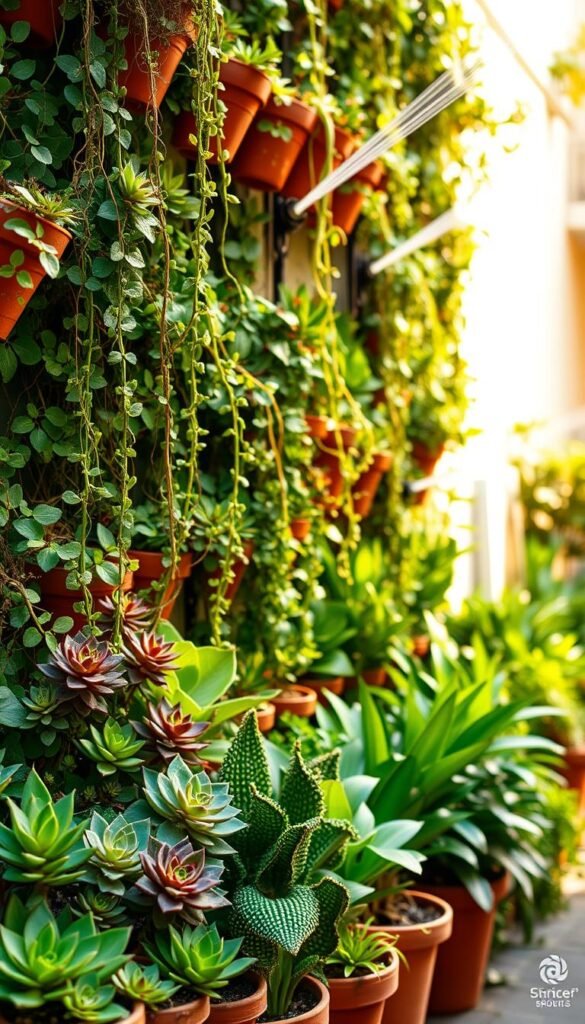
Your vertical oasis thrives when plants and water work in harmony. Light exposure dictates which species will flourish, while smart irrigation keeps roots nourished without drowning them. Let’s explore how to match greenery to your conditions and maintain ideal moisture levels.
Optimal Plant Selection for Different Light Conditions
Full sun areas (6+ hours daily) demand tough plants like sedum or lavender. For shaded spots, hart’s tongue fern adds glossy texture year-round. Mix upright and trailing varieties—try Carex grass paired with coral bells for color contrast.
| Light Condition | Top Plant Choices | Growth Habit |
|---|---|---|
| Full Sun | Sedum, Lavender | Drought-tolerant |
| Partial Shade | Heuchera, Japanese Forest Grass | Mounding/Spreading |
| Full Shade | Asplenium Fern, Fatsia Japonica | Vertical Accent |
Large-leaved plants like Fatsia make bold statements but need deeper pockets. “Restricted roots naturally limit their size,” notes landscape designer Mara Lee. This lets you enjoy dramatic foliage without constant pruning.
Essential Irrigation and Watering Techniques
Fabric pockets dry 3x faster than ground soil. Use built-in drip tubing sleeves for even watering. Most systems include timers—set them for dawn watering to reduce evaporation.
For manual setups, water 2-3 times weekly in summer. Pro tip: Insert a moisture meter into upper and lower pockets to check consistency. Adjust flow rates if top plants drown while bottom ones parch.
“Automated irrigation isn’t optional—it’s survival insurance for vertical gardens,”
Pair your plant choices with the right growing medium. Lightweight mixes with perlite improve drainage while retaining enough moisture for roots to thrive between waterings.
Best Practices in Vertical Garden Design: Green Walls and Living Fences
Your living wall’s beauty evolves with care and attention. Like any garden, these dynamic installations need seasonal tune-ups and smart problem-solving to stay vibrant year after year.
Maintenance, Seasonal Adjustments, and Plant Replacements
Schedule weekly check-ins during growing months. Trim overachievers first—fast-growing vines can block light for slower plants below. Swap out tired specimens in spring and fall, choosing compact varieties that suit your pocket depth.
Nutrients deplete quickly in vertical setups. Use slow-release fertilizer every 8 weeks, or mix liquid feed into your irrigation system. City dwellers might want to explore creative vertical gardening ideas that pair low-maintenance plants with self-watering tech.
Troubleshooting Common Issues and Optimizing Growth
Brown patches often signal uneven watering. Adjust drip emitters so upper pockets get slightly less flow than lower ones. If plants outgrow their space, divide root balls during cool mornings to reduce shock.
Every 3-5 years, refresh all soil to prevent compaction. Keep pruning shears handy—a quick snip here and there maintains airflow and prevents mold. With consistent care, your wall becomes a living legacy that matures beautifully through the decades.

